Mar
21
2024
A Hint of the Master: Jens Jensen and the Kruse House Garden
By Keith Letsche
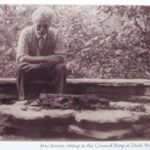
Jens Jensen seated in one of his council rings
You may have wondered where the ideas for the distinctive rock terraces and pond came from that you see in the Kruse House Garden. The source of these is likely the master landscape architect Jens Jensen (1860-1951). Born in Denmark, Jensen emigrated to Chicago in 1884, where he took employment with the city’s West Park Commission, working his way up from laborer to general superintendent of the West Park system. During this time, he designed or redesigned the system’s major parks like Humbolt, Garfield, and Douglass Parks, and his masterpiece, Columbus Park. In 1920, he started his own landscape architectural practice, creating gardens for prominent client’ s like Henry Ford and Ford’s son Edsel.
Jensen used natural features of the Midwestern landscape as themes for his designs. Terraced tiers of rocks were intended to invoke the rocky outcroppings of the Midwest’s post-glacial landscape. Often the focal point of his rocked terraces was a small grotto that featured a pond or a “council ring,” a circular arrangement of rocks for sitting. At the height of his influence in the 1920s and 1930s, his designs inspired much imitation, and the large size and natural contours of the Kruse House lot provided a perfect opportunity for the Kruses to realize what then a very contemporary garden design based on Jensen’s ideas. Compare the Kruse House lily pond below with the one next to it that Jensen designed for Henry Ford’s Fair Lane estate in Gross Point, Michigan.
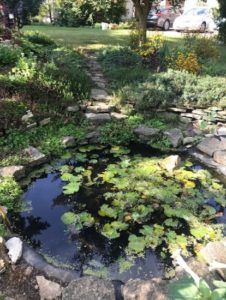
Kruse House Lily Pond
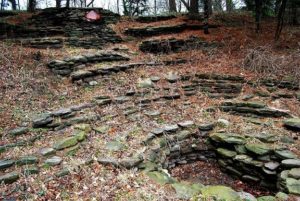
Grotto pond at Fair Lane, Henry Ford’s estate in Grosse Point. Michigan
Feb
15
2024
By Barbara Darrah
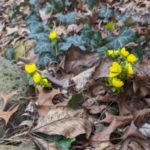 January was a long dark month this year. There wasn’t even enough sunlight to cause the snow to glisten. For the first time, our solar panels generated no electricity, and the extended subzero temperatures knocked out the heat in our greenhouse. So, it was with excitement and delight one early February morning that I discovered the dancing yellow petals of the winter aconites in our front yard. Nothing beats these early reminders of spring as winter slowly begins to fade away.
January was a long dark month this year. There wasn’t even enough sunlight to cause the snow to glisten. For the first time, our solar panels generated no electricity, and the extended subzero temperatures knocked out the heat in our greenhouse. So, it was with excitement and delight one early February morning that I discovered the dancing yellow petals of the winter aconites in our front yard. Nothing beats these early reminders of spring as winter slowly begins to fade away.
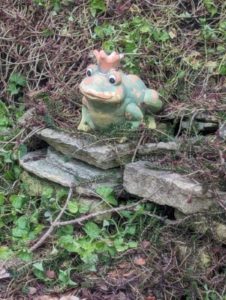 Thus it was that I decided to make a journey to the Kruse garden to see the place where I first encountered these gentle reminders of spring’s renewal. Much to my disappointment, I couldn’t find any sign of them there. Don’t get me wrong; the garden still had the quiet beauty of winter’s simplicity. The unique shapes of the trees and the bushes stood out and the little frog prince by the pond gazed longingly for just a murmur of green.
Thus it was that I decided to make a journey to the Kruse garden to see the place where I first encountered these gentle reminders of spring’s renewal. Much to my disappointment, I couldn’t find any sign of them there. Don’t get me wrong; the garden still had the quiet beauty of winter’s simplicity. The unique shapes of the trees and the bushes stood out and the little frog prince by the pond gazed longingly for just a murmur of green.
At this time of year, we can feel winter’s dull and gray grasp beginning to weaken. There is a bit more sun, a few hints of green and the hidden secrets of new life shyly begin to appear. The lethargy that comes from winter’s darkness starts to lessen and new projects come to mind. I expect that the aconites will come back at Kruse, perhaps even a snowdrop or two, and in my mind the garden will begin to grow again.
Nov
29
2023
 The Kruse House Garden is ever changing. Today the fading plants still provide a diversity of color and texture.
The Kruse House Garden is ever changing. Today the fading plants still provide a diversity of color and texture.
The Kruse Crew will be changing too. Billie Childress is retiring from working in the Kruse Garden and she will be greatly missed! For many years now Billie has headed up the crew, providing expert leadership, knowledge, generosity, and fun. Billie has led us down the right paths, resulting in a garden with “bones” and artistic structure.
Billie has donated numerous trees and perennials from her own gorgeous garden. The viburnum she donated twenty years ago has grown to fifty feet – it’s magnificent. The variety of perennials are like a kaleidoscope –vivid, beautiful and always changing. Billie has devoted an incredible amount of time and love to the garden.
Thank you Billie!



 January was a long dark month this year. There wasn’t even enough sunlight to cause the snow to glisten. For the first time, our solar panels generated no electricity, and the extended subzero temperatures knocked out the heat in our greenhouse. So, it was with excitement and delight one early February morning that I discovered the dancing yellow petals of the winter aconites in our front yard. Nothing beats these early reminders of spring as winter slowly begins to fade away.
January was a long dark month this year. There wasn’t even enough sunlight to cause the snow to glisten. For the first time, our solar panels generated no electricity, and the extended subzero temperatures knocked out the heat in our greenhouse. So, it was with excitement and delight one early February morning that I discovered the dancing yellow petals of the winter aconites in our front yard. Nothing beats these early reminders of spring as winter slowly begins to fade away. Thus it was that I decided to make a journey to the Kruse garden to see the place where I first encountered these gentle reminders of spring’s renewal. Much to my disappointment, I couldn’t find any sign of them there. Don’t get me wrong; the garden still had the quiet beauty of winter’s simplicity. The unique shapes of the trees and the bushes stood out and the little frog prince by the pond gazed longingly for just a murmur of green.
Thus it was that I decided to make a journey to the Kruse garden to see the place where I first encountered these gentle reminders of spring’s renewal. Much to my disappointment, I couldn’t find any sign of them there. Don’t get me wrong; the garden still had the quiet beauty of winter’s simplicity. The unique shapes of the trees and the bushes stood out and the little frog prince by the pond gazed longingly for just a murmur of green. The Kruse House Garden is ever changing. Today the fading plants still provide a diversity of color and texture.
The Kruse House Garden is ever changing. Today the fading plants still provide a diversity of color and texture. - Membership
- Membership